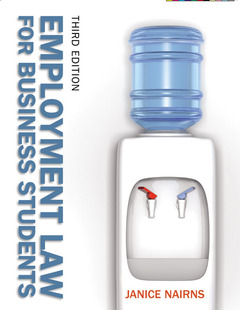Chapter one Court and tribunals, sources and institutions of employment law 1.1 Courts and tribunals 1.2 Employment Tribunals (ET) 1.3 Employment Appeal Tribunal (EAT) 1.4 Sources of employment law 1.5 How to read employment law reports and statutes 1.6 Other sources of information 1.7 Institutions of employment law Summary checklist Self-test questions Further reading Chapter two Discrimination in employment 2.1 Anti-discrimination law 2.2 What is `discrimination'? 2.3 Sex discrimination 2.4 Racial discrimination 2.5 Victimisation 2.6 What if an employer does not intent to discriminate? 2.7 Stages at which discrimination may take place 2.8 Does an employer have any defence to a discrimination claim? 2.9 Genuine occupational qualifications 2.10 Other discriminatory acts 2.11 Are employers liable for the discriminatory actions of their employees? 2.12 Positive discrimination 2.13 European sex discrimination law 2.14 Discrimination on the grounds of pregnancy 2.15 The EOC's and the CRE's codes of practice 2.16 Sexual and racial harassment 2.17 Other harassment 2.18 Discrimination on the grounds of sexual orientation 2.19 The Asylum and Immigration Act 1996 2.20 Disability Discrimination 2.21 Discrimination on the grounds of age, political persuasion or religion 2.22 Discrimination on the grounds of trade-union involvement 2.23 The rehabilitation of offenders 2.24 The Fixed-term Employees (Prevention of Less Favourable Treatment) Regulations (2002) and the Part-time Workers (Prevention of Less Favourable Treatment) Regulations (2000) 2.25 Making a discrimination claim to the Employment Tribunal 2.26 The use of equal opportunities policies 2.27 What next for discrimination law? future reform Summary checklist Self-test questions Case scenarios Further reading Chapter three The contract of employment 3.1 What is the contract of employment? 3.2 Why is the employment contract important? 3.3 The distinction between an employee and an independent contractor 3.4 Tests used to determine the status of the worker 3.5 Special categories of worker 3.6 Contents of the contract incorporation, express terms, implied terms and terms implied by statute 3.7 The right to a written statement outlining the terms and conditions of employment 3.8 Restraint of trade clauses 3.9 Qualifying for employment rights continuity of employment 3.10 Changing terms of employment 3.11 Working on a Sunday 3.12 Flexible working arrangements Summary checklist Self-test questions Case scenarios Further reading Chapter four Equal pay, maternity and other individual employment rights 4.1 Equal pay 4.2 Equal Pay Act 1970 4.3 European law, Article 141 (formerly Article 119) and the Equal Pay Directive 4.4 EOC Code of Practice on Equal Pay (1997) 4.5 Making an equal-pay claim to the Employment Tribunal 4.6 Maternity rights 4.7 The Pregnant Workers Directive 4.8 Statutory maternity rights 4.9 The right to return to work after ordinary maternity leave or additional maternity leave 4.10 Notification requirements as amended by the Employment Act 2002 4.11 Paternity and parental leave 4.12 Health and safety issues 4.13 Exclusions 4.14 Other individual employment rights 4.15 Data Protection Summary checklist Self-test questions Case scenarios Further reading Chapter five The use of disciplinary and grievance procedures 5.1 Why use disciplinary and grievance procedures? 5.2 Providing information on disciplinary and grievance procedures 5.3 The Acas code of practice: Disciplinary and Grievance Procedures (2000) 5.4 Acas handbook: Discipline at Work 5.5 Disciplinary codes and procedures 5.6 Stages involved in disciplinary procedures, investigation, counselling, hearings and appeals 5.7 Disciplinary penalties, warnings and dismissal 5.8 Procedural fairness in unfair dismissal cases 5.9 Grievance procedures 5.10 The statutory right o be accompanied at disciplinary and grievance hearings 5.11 Statutory procedures Employment Act 2002 Summary checklist Self-test questions Case scenarios Further reading Chapter six Termination of the employment contract 6.1 Overview of a wrongful dismissal and unfair dismissal claim 6.2 Ways in which an employment contract might be terminated 6.3 Termination of the employment contract at common law wrongful dismissal 6.4 Making a wrongful dismissal claim to a court or Employment Tribunal 6.5 Termination of the employment contract in contravention of a statute: unfair dismissal 6.6 The effective date of termination (EDT) 6.7 Constructive dismissal 6.8 Eligibility to make an unfair dismissal claim 6.9 Reasons why a person may have been dismissed 6.10 Fairness in relation to the five potentially fair reasons 6.11 Written reasons for dismissal 6.12 The Acas arbitration scheme 6.13 Making an unfair dismissal claim to the Employment Tribunal 6.14 Remedies Summary checklist Self-test questions Case scenarios Further reading Chapter seven Redundancy and the transfer of undertakings 7.1 the rights to a redundancy payment s 135 of the Employment Rights Act 1996 7.2 Situations which may force an employer to make employees redundant 7.3 The definition of redundancy s 139(1) of the Employment Rights Act 1996 7.4 Eligibility to make a redundancy claim 7.5 Was the employee dismissed? 7.6 The role of the employer in redundancy situations 7.7 Unfair dismissal arising from redundancy 7.8 `Bumped' redundancy 7.9 Lay-off and short-time working 7.10 Redundancy payments 7.11 What is a transfer of an undertaking? 7.12 The Transfer of Undertakings (Protection of Employment) Regulations 1981 7.13 Future developments transfer of undertakings Summary checklist Self-test questions Case scenarios Further reading Chapter eight Trade unions, collective bargaining and industrial action 8.1 Trade unions 8.2 Collective bargaining 8.3 Industrial action Summary checklist Self-test questions Case scenarios Fur




